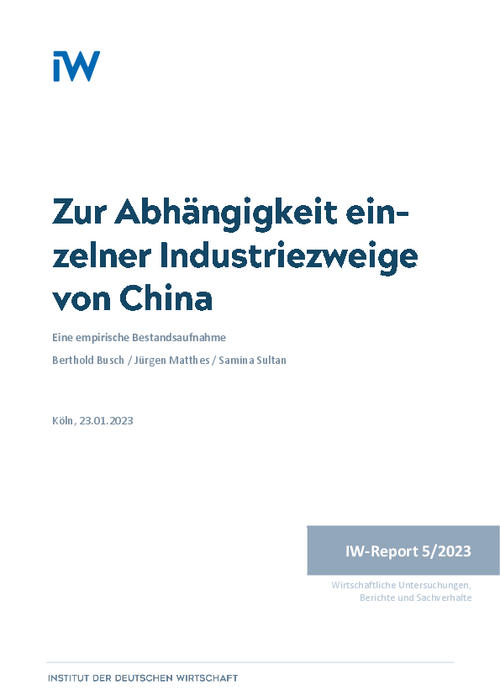The import and export dependency of German manufacturing branches on China at the intermediate input level is calculated here by evaluating the international input-output tables of FIGARO (Full International and Global Accounts for Research in Input-Output Analysis), which are provided by Eurostat with data as of 2020. On the import side, FIGARO data provide a better picture of the import dependency of industrial branches than the usual foreign trade statistics, because the latter also include imports from China that go into final demand here.

The Dependence of Individual Industries on China

The import and export dependency of German manufacturing branches on China at the intermediate input level is calculated here by evaluating the international input-output tables of FIGARO (Full International and Global Accounts for Research in Input-Output Analysis), which are provided by Eurostat with data as of 2020. On the import side, FIGARO data provide a better picture of the import dependency of industrial branches than the usual foreign trade statistics, because the latter also include imports from China that go into final demand here.
The FIGARO data, in contrast, provide imports by manufacturing industries. Overall, on this data basis, Germany's industry is not overly dependent on China in an international comparison. In 2020, an industry average of around 6.6 percent of all foreign intermediate inputs came from China. If domestic intermediate inputs are included, China's share of all domestic and foreign intermediate inputs is 2.2 percent on average for German industry. By contrast, the industry in Japan, which is much closer to China, is a lot more dependent on Chinese suppliers, with a share of almost 20 percent of all foreign intermediate inputs. Russia (16.5 percent), the USA (13.9 percent) and the Czech Republic (11.8 percent) also have double-digit shares in the industrial average among the eleven industrialized countries considered here.
At the sector level, the picture is very heterogeneous in the eleven industrialized countries. A few recipient industries have very high China import shares of foreign intermediate inputs. This is particularly true of the manufacture of computers, electronic and optical equipment (ISIC Code 26) and the manufacture of textiles, textile products and leather products (ISIC 13 to 15). On average in the eleven industrialized countries, a good 25 percent of foreign intermediate inputs in these two sectors come from China. A look at the individual industrialized countries shows that these two industries and the manufacture of electrical equipment (ISIC 27) are frequently, but not consistently, among the three most dependent recipient industries. In contrast, numerous other sectors only have higher single-digit intermediate input import ratios from China on average in the eleven industrialized countries.
In Germany, the China share of foreign intermediate inputs of the recipient industry ISIC 27 (16.1 percent) is still surpassed by ISIC 26 with 19.4 percent. In ISIC 13 to 15, the figure is 13.8 percent. These industries have a relatively strong dependence on China. Three other industries – including mechanical engineering (10.7 percent) – also have double-digit shares. In contrast, other industrial branches such as the automotive industry (6.0 percent), the chemical industry (4.1 percent) and the pharmaceutical industry (2.6 percent) have a below-average dependence on Chinese suppliers compared with the industry average of 6.6 percent. If domestic intermediate supplies are included, however, China's share of all domestic and foreign intermediate supplies is significantly lower in all sectors. Even in ISIC 26, it is only 6.6 percent.
The study also looked at which Chinese supplier industries play the most important role for which German recipient industries, including indirect intermediate input relationships. This plays a role if the intermediate inputs of a Chinese supplier industry in turn contain many intermediate inputs from another Chinese supplier industry. This analysis reveals a certain tendency toward intra-industry linkages. But it is also clear that at the intermediate input level, Chinese manufacturers of chemical products (ISIC 20), data processing equipment (ISIC 26) and Chinese metal production (ISIC 24) are directly and indirectly among the top three Chinese supplier industries for many German recipient industries.
On the export side, in contrast to foreign trade statistics, the focus is primarily on what German industrial branches supply to the economic sectors in China (and not to China's final consumption) in order to ensure an intermediate input focus here as well. For the German industry, this shows that China's relevance relative to the rest of the world is significantly greater in terms of intermediate exports supplied to economic sectors (i.e. to China's production level) than in terms of supplies to final Chinese demand, which highlights China's role as the “factory of the world". For example, the share of German intermediate goods deliveries to Chinese economic sectors in German intermediate goods deliveries to economic sectors of all foreign countries is 16.1 percent on average for German industry on average in 2020. In terms of deliveries to final demand alone, by contrast, the Chinese share is only 9.5 percent.
There are major differences between the individual German industrial sectors. In ISIC 26, for example, more than a third of all intermediate input deliveries to foreign economic sectors go to China. In the sectors ISIC 27 to 30 this share amounts to slightly more than one-fifth, which is also above average compared with the industry average of just over 16 percent. These are high shares, signalling a relatively strong export dependence on China's production base. However, it should be borne in mind that, for conceptual and methodological reasons, the FIGARO data show much higher China export shares for all industrial sectors than the foreign trade statistics. In addition, China's importance is put into perspective if the intermediate goods supplied by German industry to the domestic market are also included. China's share of intermediate input deliveries to all domestic and foreign sectors is then a good 7 percent for the industrial average.
Another data source makes it possible to determine the proportion of jobs in German industrial sectors that depend on exports to China. The analysis of the OECD's TIVA database shows that in 2018, a good 5 percent of jobs in the industrial average, or over 400 thousand jobs, depended directly and indirectly on the export of goods and services to China. In the typical strong German export sectors, the share is between a good 5 and just under 10 percent.
Looking at the two sides of foreign trade, it is noticeable that China plays a greater role for German industry at the intermediate goods level on the export side with a good 16 percent than on the import side with just under 7 percent on average. This is not the case for trade in goods based on foreign trade statistics from Eurostat, where China's shares of imports and exports are similar at around 8 percent for Germany. The difference is probably due in part to the fact that on the import side, final demand plays an important role in trade in goods, whereas this is less the case on the export side. In addition, German industrial imports of intermediate inputs are likely to focus more on European suppliers, because free trade in the Single Market is an advantage here and because geographical proximity is also important for just-in-time production. On the export side, on the other hand, German industrial intermediate exports rely relatively heavily on China's production sector as the "factory of the world". Moreover, intermediate goods exports are likely to follow German direct investment in China.
Overall, China is significant as a supplier and buyer of intermediate inputs in the industrial average, but not to an outstanding extent. However, there are some sectors with relatively strong dependencies at the intermediate input level; according to the data definition used here, this is primarily the electrical industry. In the short term, the aim here is to achieve greater diversification, i.e., a broadening of trade relations with other countries as suppliers and customers for German industry, in order to reduce dependencies on China. This is primarily the task of the companies. However, companies need political support, be it in the form of free trade agreements with other partner countries or delegation trips, as well as more investment and export credit guarantees.

The Dependence of Individual Industries on China

More on the topic

IW Financial Expert Survey: First Quarter 2018
The IW Financial Expert Survey for the first quarter of 2018 revealed that the surveyed experts predict, on average, higher interest rates and stock market indices, a depreciation of the Euro vis-à-vis the US Dollar, and lower oil prices by the end of the ...
IW
The Impact of Demographics on the German Retail Market
In recent years, net migration reached a new peak in Germany. Between 2011 and 2015, net migration amounted to more than 2.7 million people. This influx of people has had an impact on society, on the economy in general, and on most businesses.
IW